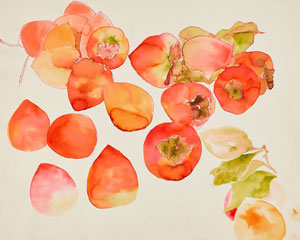1.10.24 — High-Wire Act
This has been a good year for sculpture as a high-wire act, but Ruth Asawa had a way of bringing it back to earth. Together with my earlier report on high-wire sculpture, it is also a longer review in my latest upload
Like Gego, she worked most often in wire—suggestive of the modernist impulse to reconceive sculpture as “drawing in space.” Yet she could not stop drawing everything that she saw in every medium that she touched, from what she called “potato prints” to a bentwood chair in felt tip and ink. Now the Whitney devotes an exhibition to nothing but drawing, as “Through Line” through January 15.  The title could refer to her approach to sculpture, but influence ran both ways. It took sculpture into lightness and drawing into mass.
The title could refer to her approach to sculpture, but influence ran both ways. It took sculpture into lightness and drawing into mass.
Like Gego, she worked outside the mainstream, the first in Venezuela and Asawa in San Francisco. One could almost blame Bay Area art for her obsessive touch. Both, too, were displaced by World War II, Gego as a German Jew and Asawa in the internment of Japanese Americans. She must have felt a return to art as a return to freedom, and she later attended a bastion of breaking bounds, Black Mountain College in North Carolina. Still, she kept her eye on detail, like fish scales, the pores in a cork, or the veins and outlines of a leaf. She cared way too much to let go.
Wire can come as an airy rebuke to the unbroken welded steel of sculptors from David Smith and Alexander Calder to Mark di Suvero, Tom Doyle, and Joel Shapiro. An artist simply tied her wire to hold it together. Still, sculpture for Gego can also serve as a model for architecture in 3D and in mass. For Asawa, sculpture emulates the human form, with bulges like hips. It also has an inhuman vertical symmetry, bringing it closer to abstraction. So does folded paper between drawing and sculpture.
Born in 1926, Asawa grew up on a family farm in California, near dirt roads that already must have taught her to look down. Black Mountain College encouraged her interest in origami, but her teachers had higher aspirations. She studied math with Max Dehn and a vision of the future with Buckminster Fuller. She patterned receding circles after Merce Cunningham in dance. A 1989 video shows her still learning from movement as plain as breathing. Most of all, she said, Josef Albers taught her to see, but her abstract art shows the influence of his devotion to color and nested squares as well.
She also worked in the college laundry, and she used ink stamps meant for sorting as tools for drawing. It was the closest she ever came to conceptual art, but already repetitive in the extreme, one bed linen or shirt after another. Later, with kids in school, she picked up on the pleats in their clothing. The curators, Kim Conaty and the Menil Drawing Institute’s Edouard Kopp, speak of the found and transformed. They also arrange the show by themes, although I have trouble telling them apart. Still, it suits an art so determined that it barely changes from her return to California to her death in 2013.
She loved dance, but not as a collaborator among friends like Robert Rauschenberg. She was instead a lifetime learner, and she learned from everything. Her forms within forms include tree rings in the regions redwood forests, but she was just as fond of plane trees in the city, in Golden Gate Park. For Asawa, it gets hard to separate nature and culture, no more than fish scales and laundry stamps. Other sections of the exhibition speak of rhythms and growth patterns—patterns that she could have discovered or imposed. Maybe both at once.
Asawa’s art can feel fussy and claustrophobic. Even in sculpture, it took Gego before her and Senga Nengudi to come to show how nested shapes could flex and bend of its own weight. Sometimes, though, what she saw rescued her from all that she was hoping to do. As Paul Cézanne said about Claude Monet, she was “only an eye but what an eye.” The same chairs that bring the texture of wood also temper the fuss by appearing as in her work white silhouettes. While her drawing has mass, her wire is light enough to suspend from a thread.
Read more, now in a feature-length article on this site.